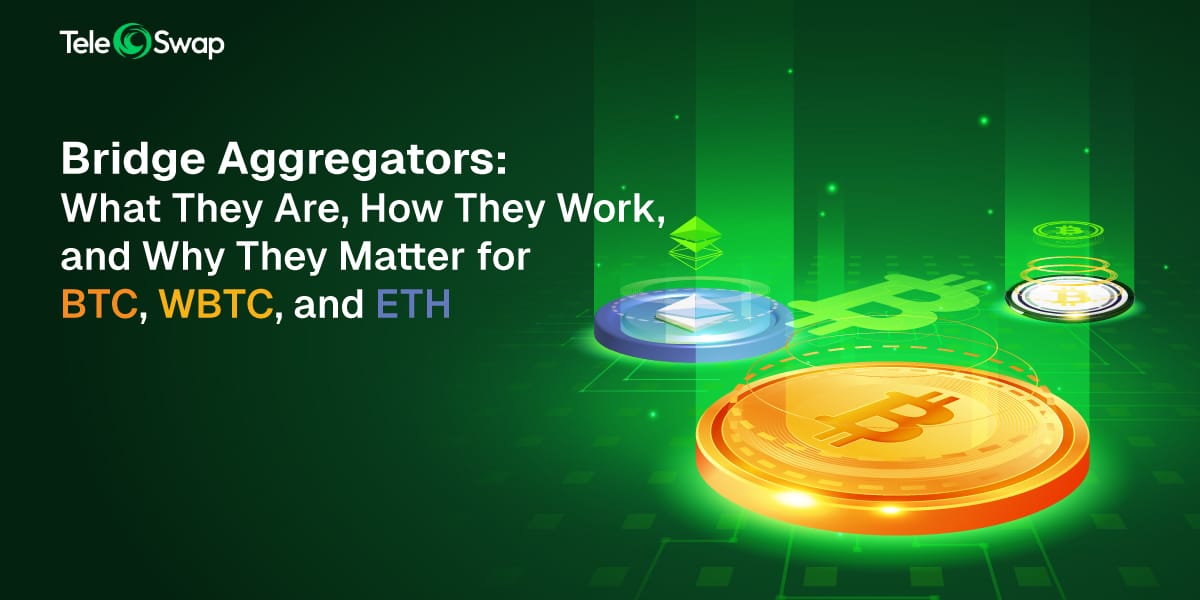Bridge Aggregators: What They Are, How They Work, and Why They Matter for BTC, WBTC, and ETH

The world of cryptocurrency is no longer confined to a single blockchain. With Bitcoin, Ethereum, and countless other networks thriving, the need to move assets across chains has never been greater. Whether you want to bridge BTC to ETH (move Bitcoin onto Ethereum), convert Bitcoin into its wrapped ERC-20 form (bridge BTC to WBTC), or swap assets between any two networks, doing so efficiently can be challenging. This is where bridge aggregators come into play. Bridge aggregators help users find the best rates and fastest routes when transferring tokens across blockchains, simplifying a once complex process. In this blog post, we’ll explain what bridge aggregators are, how they work, and why they’re important for bridging crypto assets like BTC, WBTC, and ETH. We’ll also mention some leading aggregators (Rubic, Rango, and DZap) and discuss how high-performance bridges like TeleSwap fit into the picture. By the end, you’ll understand how to seamlessly move your tokens across chains – and why tools like TeleSwap often emerge as top choices for speed, cost, and reliability.
The Need for Cross-Chain Bridges
In the early days of crypto, most activity happened on isolated blockchains. Bitcoin (BTC) stayed on the Bitcoin network, Ether (ETH) stayed on Ethereum, and so on. As decentralized finance (DeFi) and multi-chain ecosystems grew, users increasingly wanted to leverage their assets on different chains. For example, a Bitcoin holder might want to use their BTC in Ethereum’s DeFi apps, or an Ethereum user might want to move assets to a faster or cheaper network. Crypto bridges make this possible by allowing tokens and value to transfer from one blockchain to another. Without bridges, the crypto ecosystem would remain siloed and less efficient.
However, bridging assets isn’t always straightforward. Traditional bridges often require wrapping tokens (locking the original asset and minting a representation on the target chain). Wrapped Bitcoin (WBTC), for instance, is an ERC-20 token on Ethereum that represents BTC. Getting WBTC typically involves sending BTC to a custodian who mints WBTC on Ethereum – a process that can be slow and centralized. Similarly, moving ETH or stablecoins across chains might involve using specific bridge protocols or swapping through exchanges. Users face questions like: Which bridge offers the best exchange rate? Which one charges the lowest fees? How long will the transfer take? The wrong choice could mean higher costs, longer wait times, or even security risks. The history of crypto bridges is fraught with incidents (e.g., major bridge hacks on Ronin, Binance Bridge, Wormhole) that underscore the importance of using reputable, secure solutions.
Bridge aggregators emerged to simplify this decision-making. Much like a travel aggregator finds you the best flight route and price, a bridge aggregator finds you the optimal path to move your tokens from Chain A to Chain B. If you’ve ever been unsure how to swap BTC to WBTC, or transfer assets between two blockchains, a bridge aggregator handles the heavy lifting by searching multiple services and giving you the best option in seconds.
What Are Bridge Aggregators?
A bridge aggregator is a platform (or service) that aggregates multiple bridge and swap protocols under one roof to streamline cross-chain transfers. Instead of being a single bridge, the aggregator connects to many different bridges and even decentralized exchanges (DEXs) across various networks. It then routes your transaction through the most efficient path available. In simpler terms, a bridge aggregator is an all-in-one routing engine that finds the fastest, cheapest, and safest way to get your token from one blockchain to another.
Leading examples of bridge aggregators include platforms like Rubic, Rango, and DZap (among others). These services integrate dozens of bridges and exchanges behind the scenes. For the end user, the aggregator provides a one-stop interface: you specify the asset you have (e.g., BTC on Bitcoin) and the asset you want on the destination chain (e.g., WBTC on Ethereum, or possibly ETH itself), and the aggregator takes care of determining the best way to get there.
Definition: Rango Exchange (a cross-chain swap aggregator) describes itself as “a new layer on top of all Bridges and DEXs, working as a Bridge Aggregator and DEX Aggregator at the same time to enable seamless on-chain and cross-chain swaps, finding the most efficient, safe, cheap and fast route” for any token on any blockchain. This encapsulates what bridge aggregators do: they sit on top of multiple liquidity sources and calculate the best route so you don’t have to manually compare options.
Similarly, MetaMask (the popular crypto wallet) introduced an aggregator feature called MetaMask Bridges to help users “find the best routes to move your tokens from one chain to another,” removing the guesswork of picking from many bridging options. In essence, bridge aggregators serve as smart navigation systems for the multi-chain world, guiding your tokens through the optimal path.
How Do Bridge Aggregators Work?
Behind the friendly UI, a bridge aggregator performs complex routing logic. When you enter a desired transfer (for example, bridge 1 BTC from the Bitcoin network to Ethereum), the aggregator’s engine queries all its integrated bridges and cross-chain swap providers to gather quotes and possible routes. Each route may involve different steps or intermediate tokens. The aggregator will consider factors such as:
- Exchange Rate / Output: How much of the target asset will you get for your source asset after all fees? Some bridges might offer better rates or lower fees than others.
- Fees: This includes bridge fees, network transaction fees on the source and destination chains, and any service fees. The aggregator looks for the lowest overall cost.
- Transfer Time: Some routes are faster than others. For instance, a route that uses a slow chain or requires many confirmations (like Bitcoin) may take longer. The aggregator can favor faster routes if speed is a priority.
- Security and Reliability: Aggregators often integrate only vetted bridges. They might weigh routes by the reputation of the underlying protocol. (MetaMask, for example, curated a set of bridges it deemed secure when launching its aggregator.)
After evaluating the options, the aggregator will present the optimal route (and sometimes alternate routes) to the user. For example, suppose you want to bridge BTC to ETH (receiving ETH on Ethereum for BTC on Bitcoin). The aggregator might find Route A that uses a direct BTC-to-ETH swap via a protocol like TeleSwap and THORChain, Route B that converts BTC to WBTC through a fast bridge, then swaps WBTC to ETH on a DEX, and Route C that goes via an intermediate stablecoin. If Route B yields the most ETH in your wallet and takes the least time, the aggregator will suggest that as the primary path.
From the user’s perspective, you simply approve the transaction, and the aggregator coordinates the rest. It may split the transaction into steps under the hood – for instance, swapping your BTC for WBTC through Bridge X, then trading WBTC for ETH on DEX Y – but all of this is abstracted away into one smooth experience. In a few clicks, you achieve what would otherwise require juggling multiple apps or platforms.
The power of bridge aggregators is that they make cross-chain swaps feel easy. Instead of manually researching how to move an asset (and potentially making a costly mistake), you rely on the aggregator’s algorithms. As Rango’s documentation highlights, the goal is to enable “swapping from any token on any blockchain to any other token on any blockchain,” in the most efficient way possible. That means even complex journeys (like exchanging a token on Polygon for another token on Solana, which might involve several hops) can be handled automatically.
Benefits of Using a Bridge Aggregator
Why use a bridge aggregator instead of going directly to a single bridge or exchange? Here are the key benefits:
- Best Rates Automatically: Aggregators compare many options to get you the best exchange rate and output for your swap. You don’t have to shop around – the aggregator’s “Best Rate Finder” does it for you. For example, if one bridge would give you 0.95 ETH for your BTC and another would give 1.0 ETH, the aggregator will identify the better 1.0 ETH route.
- Faster Transfers: By evaluating routes, an aggregator can find the fastest way to bridge. If one path takes 30 minutes but another can do it in 5 minutes, you’d likely prefer the latter. The aggregator’s recommendation engine often prioritizes speed alongside cost. In practice, this means you can get your assets across chains quicker. For instance, MetaMask’s aggregator emphasizes both cost and time efficiency in its routing.
- Lower Fees: Bridge aggregators aim to minimize fees. They not only find the lowest-fee providers, but some aggregators also batch steps to save on gas costs or use their token economics for discounts. The net effect is often a cheaper transfer than going via an arbitrary route. As an example, Rubic (a DEX and bridge aggregator) gives users access to 15,500+ assets across 90+ blockchains with optimal rates and liquidity – essentially ensuring you don’t overpay for cross-chain trade.
- Increased Safety: Reputable aggregators integrate trusted bridges and can filter out risky routes. This curation provides a layer of security – you can avoid sketchy, unaudited bridges because the aggregator has already selected known providers. This is crucial given past bridge hacks; using an aggregator that vets bridges gives peace of mind.
- Convenience: Perhaps the biggest benefit is ease of use. With a single interface and a few clicks, you accomplish what used to require multiple manual steps (moving tokens into an exchange, swapping, withdrawing to another chain, etc.). Aggregators remove the need to manage multiple wallets or accounts for different networks in one go. The time and effort saved are significant, especially for newcomers. It makes advanced DeFi moves accessible to a broad crypto audience without steep learning curves.
In short, a bridge aggregator finds you the best deal and handles the complexity, so you can focus on what you want to achieve (like getting your BTC onto Ethereum or vice versa) without worrying about the underlying mechanics.
Bridging BTC, WBTC, and ETH: Real-World Examples
Let’s look at a couple of common cross-chain scenarios and how a bridge aggregator enhances them:
- Example 1: Bridging BTC to Ethereum (BTC → ETH). Suppose you hold Bitcoin but want to participate in Ethereum’s DeFi or buy an NFT that’s only sold for ETH. You need to go from BTC on the Bitcoin network to ETH on Ethereum. Without aggregators, you might consider using a centralized exchange: deposit BTC, trade it for ETH, then withdraw ETH to your wallet – a process that involves fees and delays (exchange deposit/withdrawal can easily take 30+ minutes). Alternatively, you could use a single cross-chain protocol like TeleSwap and THORChain to swap BTC for ETH, but you’d have to trust that route and possibly deal with slippage and liquidity issues. A bridge aggregator can streamline this. It will scan multiple routes such as:
- Route A: Use a trustless bridge (e.g., TeleSwap or THORChain) to convert BTC directly to an Ethereum token, then perhaps swap that token to ETH.
- Route B: Convert BTC to WBTC through the best available bridge, then unwrap WBTC to BTC or swap WBTC to ETH on a DEX.
- Route C: Use an intermediate stablecoin (sell BTC for USDC on one chain, bridge USDC, then buy ETH on the target chain).
- The aggregator might determine that Route A via a high-performance bridge, like TeleSwap gives the best result: minimal BTC slippage, low fees, and quick final delivery of ETH. In fact, with the right bridge, the entire transfer can complete in just a few minutes, as opposed to tens of minutes or hours via other methods. You as the user simply confirm the transaction the aggregator suggests, and you’ll see ETH in your Ethereum wallet soon after. The aggregator takes care of finding that TeleSwap (or other) route that yields, say, slightly more ETH and confirms faster than other options.
- Example 2: Bridging BTC to WBTC (Bitcoin <-> Wrapped Bitcoin). This is a common need for Bitcoin holders who want to use their BTC in Ethereum’s ecosystem (since WBTC is a 1:1 representation of BTC on Ethereum). Traditionally, converting BTC to WBTC involves going through WBTC’s custodian partners – a somewhat centralized process that can even take days for redemption (unwrapping WBTC back to BTC) and requires KYC with a merchant in some cases. Bridge aggregators now present trustless alternatives. If you use an aggregator to swap BTC to WBTC,, it might suggest a route using TeleSwap, because TeleSwap specializes in bridging between native BTC and ERC-20 BTC tokens in a decentralized way. TeleSwap provides a “fast, cheap, and trust-minimized way to get your BTC out of WBTC, without going through a centralized exchange or provider”. In practice, this means you could convert, for example, 1 WBTC on Ethereum back into 1 BTC in your Bitcoin wallet in under 3 minutes – a process that would otherwise require trusting a custodian and waiting potentially hours or days for official redemption. The aggregator will find this route if it’s the best, and you, as the user, just follow the prompt. Thanks to TeleSwap’s efficiency, users report seeing BTC delivered to their wallet about 2–5 minutes after confirming the swap, which is incredibly fast compared to any traditional method. The fees are transparent and minimal (TeleSwap charges roughly a 0.1% service fee plus network fees, which in many cases is cheaper than alternatives when you factor in exchange spreads or custody fees).
These examples highlight how bridge aggregators can identify optimal paths that you might not easily find on your own. Whether it’s wrapping Bitcoin (BTC → WBTC), unwrapping (WBTC → BTC), or moving between major ecosystems like Bitcoin and Ethereum (BTC ↔ ETH), the aggregator simplifies the user experience. It ensures you get the best rate with the least hassle. Importantly, if one prefers a certain type of route – say, avoiding centralized bridges – the aggregator’s recommended path can often be a decentralized, trust-minimized route like TeleSwap, so you maintain the ethos of crypto by not relying on middlemen.
Leading Bridge Aggregators in the Market
As the DeFi world has expanded, several bridge aggregators have risen to prominence, each offering a gateway to numerous chains and tokens. Here are a few of the leading platforms:
- Rubic: Rubic is a popular cross-chain swap aggregator that combines over 100 blockchains and 360+ integrated exchanges and bridges into one interface. It bills itself as a “Best Rate Finder” for users and dApps, capable of aggregating 220+ DEXs and cross-chain bridges to ensure you get optimal rates. With Rubic, you can swap between more than 15,500 assets with one click, without needing to know which underlying bridge is being used. For example, bridging Ethereum to a non-EVM chain or swapping tokens across Polygon, BNB Chain, Avalanche, etc., can all be done in one place. Rubic’s smart routing abstracts away complexity so well that users “seamlessly execute trades across various blockchains without needing to understand the intricacies of each network”. In short, Rubic is a one-stop aggregator making cross-chain swaps simple and secure.
- Rango: Rango is a cutting-edge cross-chain aggregator that acts as both a DEX aggregator and a bridge aggregator. It has integration with 73+ blockchains and 120+ DEX/bridge protocols, making it extremely versatile. Rango’s philosophy is to be a “universal” swap platform – you can trade native assets like BTC, ETH, MATIC, and others between any chains in a decentralized manner. Under the hood, Rango’s routing algorithm can even split transactions or use multi-path routes to ensure the most efficient, safe, cheap, and fast swap for the user. This means if a single route can’t give you the best result, Rango might combine liquidity from multiple sources. The result for the user is a secure swap across even obscure chain combinations. Rango has positioned itself as “a new layer on top of all Bridges and DEXs” to enable seamless cross-chain trading. If you’re looking to swap “anything to anything, anywhere,” Rango is a go-to aggregator.
- DZap: DZap is known as a “Meta Bridge Aggregator,” meaning it doesn’t just aggregate individual bridges – it even aggregates other aggregators. This platform combines liquidity and routes from multiple DEXs and bridges into a single unified interface. By tapping into 15+ bridges (and their aggregators) and 20+ DEX sources, DZap ensures users get the best prices, lowest slippage, and highest liquidity without needing to check every platform themselves. For instance, if you want to move tokens across an unusual chain pair, DZap will leverage all available tools (including possibly calling Rango’s API, as they’ve partnered) to find a solution. Key features of DZap include support for multi-chain batch swaps (bridging multiple tokens in one go) and even automated strategies like dollar-cost averaging across chains. It’s a powerful aggregator-of-aggregators aimed at unifying the DeFi experience.
Each of these aggregators contributes to a more connected crypto ecosystem, allowing users to bridge assets like BTC, WBTC, ETH, and thousands of other tokens with ease. They turn the once difficult task of finding a cross-chain path into a quick query. And notably, they often feature the same high-performance bridges as part of their routing options – which brings us to TeleSwap.
TeleSwap: A High-Performance Bridge Featured by Aggregators
It’s important to clarify the distinction between a bridge aggregator and a bridge. TeleSwap is not a bridge aggregator; rather, it is a decentralized cross-chain bridge protocol – essentially one of the bridging solutions that an aggregator might use. What makes TeleSwap special is its focus on Bitcoin and related assets. In fact, TeleSwap is sometimes called “the ultimate Bitcoin bridge” for its ability to seamlessly connect BTC and Bitcoin-based tokens to other networks. It is built on TeleportDAO’s technology (using a light-client approach) to enable trustless, high-speed transfers between Bitcoin and EVM-compatible blockchains, as well as the TON blockchainTeleSwap’s role within aggregators is as a top-performing route whenever Bitcoin needs to be bridged. Aggregators like Rubic, Rango, and DZap integrate TeleSwap as one of their available bridges. When a user requests, say, to bridge BTC to an Ethereum asset, the aggregator may very well select TeleSwap’s route if it offers the best combination of speed, fees, and reliability. And often it does – here’s why:
- Speed: TeleSwap is extremely fast for a Bitcoin bridge. Thanks to its efficient design, a cross-chain swap involving BTC can often be completed in under 3 minutes for typical transaction sizes. Many users report seeing the bridged funds appear in just 2–5 minutes, which is a game-changer compared to older methods that might take half an hour or more. In fact, official processes for moving BTC to WBTC can take hours or days in some cases, whereas TeleSwap finalizes in minutes. This focus on speed (achieved by not waiting for excessive confirmation delays, yet still maintaining security through clever mechanisms) means that when an aggregator is prioritizing quick execution, TeleSwap shines as a route.
- Low Fees: TeleSwap offers competitive fees. The protocol charges about 0.1% of the bridged amount as a service fee (paid to its decentralized node operators), plus the necessary network fees to execute transactions. A 0.1% fee is quite modest in the realm of cross-chain transfers – for comparison, centralized exchanges might charge more than that in spread or withdrawal fees, and other decentralized bridges sometimes have higher percentage fees or hidden slippage. TeleSwap’s fee structure is transparent and “cheap” for users. Aggregators looking to maximize the output for the user will take into account these low fees, often finding TeleSwap’s route yields more of the target asset for the user than other bridges that might have higher fees or worse exchange rates.
- Reliability and Security: TeleSwap is built to be trust-minimized and decentralized, meaning users do not have to trust a single custodian or centralized entity with their BTC. It uses a light-client bridge that brings Bitcoin-level security assurances to the process. For users, this means bridging BTC via TeleSwap doesn’t carry the custodial risk that something like WBTC does (where you trust a company to hold your BTC). TeleSwap’s protocol has mechanisms (like a slashing system for its nodes) to ensure honest behavior and robust operation. In aggregator terms, reliability translates to successful, seamless swaps. TeleSwap has proven reliable, and it’s being tracked on platforms like DeFiLlama as a notable bridge solution. In fact, TeleSwap was one of the first live-tracked bridge protocols on the TON blockchain, illustrating its innovation in that space. All of this makes TeleSwap a preferred route in aggregator algorithms, since an aggregator’s goal is not just the best rate, but also a successful, secure execution of the transfer.
Crucially, TeleSwap fills a gap in the market: it gives Bitcoin holders a way to transfer or exchange their BTC for other tokens without involving any centralized entity. In other words, TeleSwap acts like a decentralized Bitcoin exchange (a “Bitcoin DEX”) bridging to other chains. For users who value security and independence, seeing TeleSwap as the chosen route in an aggregator provides confidence that the bridging process is aligned with crypto’s trustless principles.
To summarize, while TeleSwap itself is not an aggregator (you can use TeleSwap directly via its own interface to perform cross-chain swaps), its integration into top aggregators means that many users benefit from TeleSwap without even realizing it. Whenever you use a bridge aggregator and it selects TeleSwap as the routing path, you’re getting the advantages of TeleSwap’s speed, low cost, and security through the aggregator’s convenience. TeleSwap’s presence on platforms like Rubic, Rango, or DZap is a testament to its performance; it’s there because it often provides the best route for BTC-related transfers.
Conclusion: Embracing Seamless Cross-Chain Swaps
As blockchain technology evolves, interoperability is becoming the cornerstone of a connected crypto ecosystem. Bridge aggregators have emerged as indispensable tools for anyone looking to move assets across chains. They demystify the process to bridge BTC to ETH, bridge BTC to WBTC, or swap any token for another across different networks, all while optimizing for speed, cost, and reliability. By using a bridge aggregator like Rubic, Rango, or DZap, users can save time, money, and headaches, getting the best deals without needing to be experts in each bridging protocol.
Equally important are the advanced bridges under the hood that make these optimal routes possible. TeleSwap, in particular, demonstrates how a well-designed cross-chain bridge can significantly improve the user experience for moving Bitcoin and other assets. It tackles the long-standing issue of connecting Bitcoin with the DeFi world in a decentralized manner, and it does so so efficiently that aggregators frequently highlight it as the top choice for BTC transfers. In the end, the combination of smart aggregators and high-performance bridges is delivering a new level of freedom to crypto users.
Ready to experience seamless cross-chain swapping for yourself? You can try a bridge aggregator to compare rates and see how effortless it is to move value between networks. And if you’re dealing with Bitcoin or wrapped Bitcoin, keep an eye out for TeleSwap in the routing results – its speed and low fees might surprise you. You can even try TeleSwap directly via its app for a quick, decentralized bridge of BTC. The next time you need to swap assets across chains, whether it’s swapping BTC to WBTC or any other combination, let these tools do the heavy lifting. With top aggregators and TeleSwap at your service, jumping between blockchains is no longer a daunting task but an opportunity to explore the full breadth of what crypto has to offer.




